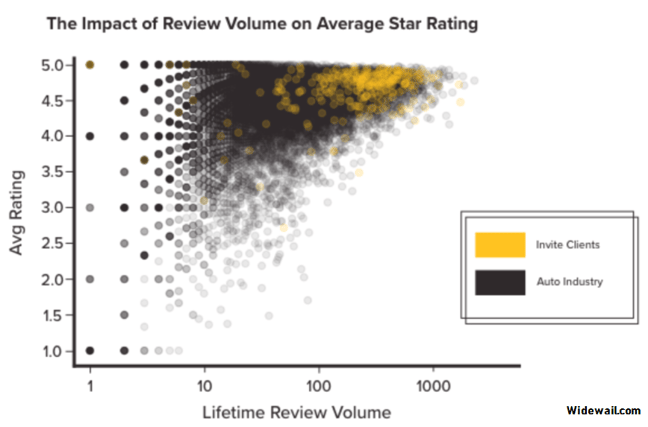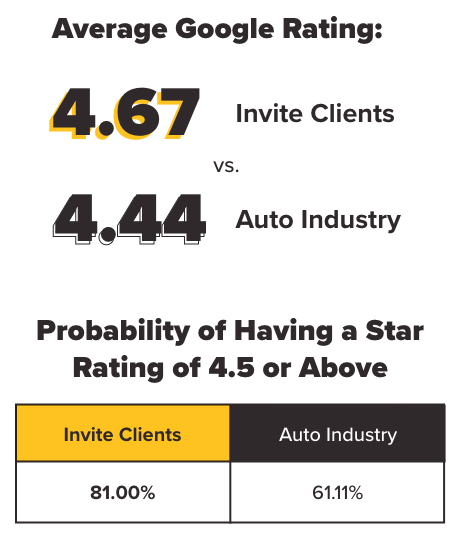How do you increase your business's Google star rating using reviews? These key points will help activate the voice of happy customers while reducing negative commentary.

How do you increase your local business's average Google star rating?
Great question.
Activating the voice of your happy customer by asking for reviews is our favorite answer. But the more obvious response is to improve the customer experience at the store level. A better customer experience will lead to more positive reviews and will result in a higher Google star rating.
But that's not your only option. There are tactical moves you can make to get better content on your Google review page, optimizing which customer stories end up front and center.
What IS the ideal average Google review star rating?
Over the last 10 years, the average Google star rating has increased from 3.72 to 4.11, a nearly 10% lift, primarily due to improvements in online reputation and review management.
Widewail has recently collected proprietary data from the first half of 2023, which includes an analysis of 1.6 million Google reviews left by customers of 16,000 new car dealerships. The result is a data-driven illustration of the undeniable relationship of Google review volume to improving star ratings.
Higher average Google Business Profile star ratings are directly linked to the volume of reviews received, and the percentage of positive vs. negative feedback. Our research has consistently shown that actively soliciting reviews leads to a greater representation of the overall customer base which elevates ratings. But without proactive review requests, dissatisfied customers are more likely to provide feedback than happy customers, leading to a higher negative percentage and, therefore, lower Google star ratings.
Our analysis of Google review data confirms this relationship, as ratings consistently increase with higher review volume. Visualizing this connection through a scatterplot image, we observe the number of reviews (x-axis) and average star rating (y-axis). The strength of color represents frequency, providing a clear representation of the pattern. Notably, we have marked the 4.5-star rating threshold, which usually signifies a high-performing rooftop.

Dealerships leveraging Widewail Invite (our SMS review request solution) are denoted in blue, while the industry is represented in orange. Across all dealerships, a discernible positive correlation emerges between review volume and rating, as evidenced by the upward trend in data points as review volume increases.

It is worthwhile for those in automotive (and all other industries) to recognize that a higher number of positive reviews impacts their GBP star rating. By actively soliciting and engaging more customers, dealerships can enhance their online reputation and attract a wider audience. See how your dealership stands against competitors in Widewail's Automotive Reputation Index.
Most likely, you have hundreds of happy customers every month. Whether your business handles it in-house or is using a Google review service, the strategies to increase your star rating discussed in this article will help you convert more of those experiences into public information that will bolster your online reputation.
Before we get into how to increase a Google star rating, let’s dig into the fundamentals around how they are tabulated.
Google used to display local search results primarily based on physical location; which bakery was closest in proximity to the user. Now, if you want to know where to get a scone in between meetings, increasingly it also includes the most popular bakery, even if it adds 10 minutes to your trip.
John Mueller, Senior Search Analyst for Google, reports that while Google doesn’t factor star ratings and customer reviews into national search rankings, star ratings do have a significant influence on local search results.
“Google review count and review score factor into local search ranking. More reviews and positive ratings can improve your business’s local ranking.”
Google encourages businesses to solicit and reply to customer reviews, and when 48% of consumers won’t even consider a business with less than a 4-star rating, we believe this is a must in your reputation management strategy.
We’ll dive into each bullet point specifically throughout this blog, but here is a shortlist of best practices each business should take into consideration when looking to increase Google reviews:
Widewail has created a helpful Google star rating calculator that shows you where your business currently stands, and you can estimate how many reviews are required to increase that rating. Check it out!
Easier said than done, but the first step towards improving your Google star rating is to begin requesting more reviews. And to be doing it comprehensively, every time for every customer.
If you imagine a cross-section of your customers, the majority will have their needs met with an overall satisfactory experience.
They got what they came for.
This means that, unless asked, they likely won’t leave a review. Customers often don’t give it a second thought when an expectation goes according to plan.
By comparison, a poor experience drives action. Motivation to share their experience, saving others from being wronged as they have been wronged. Totally understandable.
Because of this, your business has an opportunity. Ask and you shall receive. Prompt all of your customers to provide feedback and more happy customers will get into the mix.
We’ve found that the best way to receive more positive reviews is to simply ask. Emphasis on the word “simply”. Make it easy for customers to leave you feedback, and then ask everyone to participate.
The Tactic:
Drown out negative feedback in a sea of positive reviews.

Now that you’ve asked your customers, to get them to the finish line you need to make it easy to leave a review.
It should be as straightforward as looking up directions on Google Maps.
If you do this right, more happy customers will take the 30 seconds required to toss a 5-star review online. The effort required is commensurate with the loyalty they feel to your business.
For many, it’s only a little, but that is enough for your brand to capitalize on and should help increase Google reviews.
*Important: After someone leaves a new review, it may take up to 2 weeks to get an updated Google review score.
The Tactic:
We have our phones on hand almost all the time. So to successfully gain more reviews, we recommend using SMS. Text is a direct and easily accessible method of communication. It's also private and subject to TCPA oversight. Because of this, it needs to be utilized responsibly, but asking for a review post-transaction is 100% reasonable.
Once opened, an SMS review invite needs to direct the reader to your review page on their phone in just a couple of clicks. If the customer is submitting a star rating and a quick line of feedback the whole process might take 20 seconds.
You would take 20 seconds to leave a review, right? It’s like asking for a quarter, it’s worth something, but most of the time we won’t think twice about parting with one.
3. Personalize responses
Putting yourself in the shoes of the shopper for a moment, imagine you just bought a couch. Sam the sales representative helped you find the right one and completed your transaction.
Later that day you get a message.
A: “Thank you for shopping at Jim’s Furniture Outlet. Please take a moment to leave a review: (insert link here)”
Or
B: “Hey Taylor, this is Sam from Jim’s Furniture Outlet. Your feedback is very helpful to our team, helping us determine what we are doing right and where we can improve. Would you please take a moment to leave us a review? (insert link here)"
Which one is more compelling? Of course, it’s message B.
The Tactic:
A personalized message will help with recall, increase the likelihood of a review, and drive action.
Just like Tom Brady trying to get a high-five on the sidelines, sending in feedback and getting no response is a letdown.
An HBR study of TripAdvisor data found that when a business begins responding to reviews on average review volume increases by 12% and ratings increase by 0.12 stars. Thinking about this on a human level, if your customers see that you're engaging with customer feedback they will be more compelled to share their thoughts.
Also, don’t ignore your unhappy customers. Respond promptly, professionally and respectfully. Request to speak further offline so you can help solve the problem. We have put together an entire guide to help when you find yourself faced with an unhappy customer.
We see it all the time. When a business actively works towards a solution, the unsatisfied customer feels seen, heard, and oftentimes updates their review to reflect the most recent positive experience.
Tactics:
Going back to the intro, all of the tactics discussed above will help you optimize your star rating, but foundationally - the in-store experience needs to be exceptional for the customer first.
Reviews are a great source of continuous feedback, allowing you and your team to fine-tune here and there and, worst-case scenario, perform brand reputation crisis management.
Tactic:
Consumers rely on authentic reviews to provide a trustworthy, unbiased reflection of a company to help them make a sound decision.
The Federal Trade Commission (and Widewail) feel very strongly that the honest opinions of customers should never be manipulated by purchasing or writing fake reviews, which is a common form of online review fraud. Violating the FTC Act could result in damaging your business’s online reputation.
“Under this Act, as amended, the Commission is empowered, among other things, to (a) prevent unfair methods of competition and unfair or deceptive acts or practices in or affecting commerce; (b) seek monetary redress and other relief for conduct injurious to consumers; (c) prescribe rules defining with specificity acts or practices that are unfair or deceptive, and establishing requirements designed to prevent such acts or practices; (d) gather and compile information and conduct investigations relating to the organization, business, practices, and management of entities engaged in commerce; and (e) make reports and legislative recommendations to Congress and the public. A number of other statutes listed here are enforced under the FTC Act.”
That being said, setting up a reputation management strategy to improve your Google star rating is a goal worth attaining. The most verifiable way to ensure that your brand’s online reputation is dependable is to welcome and respond to any and all feedback from consumers.
Using this approach, Widewail clients see an average ratings jump from 4.4-4.7, and even more for businesses with a lower rating to begin with.These six steps will help you activate the voice of your already-existing happy customers, drown out negative commentary, convert unhappy customers to happy ones, and protect a high Google star rating.
* Originally published on 4/9/21. Updated on 3/24/23
Widewail is a reputation management software and services company based in Burlington, VT. We help hundreds of small local businesses and national brands like Lexus and BH Property Management generate and respond to reviews.
Learn more about our core products:
Engage: Review response managed services
Invite: Send automated SMS review requests to all your customers
Invite Video: Automated video testimonial generation
Listings Management: 75+ business sites/directories managed from one dashboard
I’m the Director of Marketing here at Widewail, as well as a husband and new dad outside the office. I'm in Vermont by way of Boston, where I grew the CarGurus YouTube channel from 0 to 100k subscribers. I love the outdoors and hate to be hot, so I’m doing just fine in the arctic Vermont we call home. Fun fact: I met my wife on the shuttle bus at Baltimore airport. Thanks for reading Widewail’s content!
Bite-sized, to-the-point, trend-driven local marketing stories and tactics.
U3GM Blog Post Comments